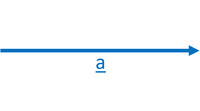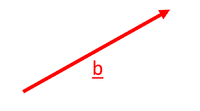Difference between revisions of "Vector"
(→About Vectors) |
|||
| Line 12: | Line 12: | ||
===Representing Vectors=== | ===Representing Vectors=== | ||
| − | : [[Vector]]s are written with either an underline (<math>\underline{F}</math>,<math>\underline{s}</math>,<math>\underline{v}</math>,<math>\underline{a}</math>) or an arrow above (<math>\overrightarrow{F}</math>,<math>\overrightarrow{s}</math>,<math>\overrightarrow{v}</math>,<math>\overrightarrow{a}</math>) | + | : [[Vector]]s are written with either an underline (<math>\underline{F}</math>,<math>\underline{s}</math>,<math>\underline{v}</math>,<math>\underline{a}</math>) or an arrow above (<math>\overrightarrow{F}</math>,<math>\overrightarrow{s}</math>,<math>\overrightarrow{v}</math>,<math>\overrightarrow{a}</math>). |
: [[Vector]]s are often drawn on [[diagram]]s. They are drawn as an arrow because an arrow can show the [[magnitude]] (the length of the arrow) and the direction (which way the arrow is pointing). | : [[Vector]]s are often drawn on [[diagram]]s. They are drawn as an arrow because an arrow can show the [[magnitude]] (the length of the arrow) and the direction (which way the arrow is pointing). | ||
| − | + | {| class="wikitable" | |
| + | |- | ||
| + | |[[File:Vectora.png|center|200px]] | ||
| + | |[[File:Vectorb.png|center|200px]] | ||
| + | |- | ||
| + | | style="height:20px; width:200px; text-align:center;" |The [[vector]] <math>\underline{a}</math> is shown by this arrow. The length of the arrow represents the [[magnitude]] of the [[vector]] and the direction of the arrow shows the direction of the [[vector]]. | ||
| + | | style="height:20px; width:200px; text-align:center;" |The [[vector]] <math>\underline{b}</math> is shown by this arrow. The length of the arrow represents the [[magnitude]] of the [[vector]] and the direction of the arrow shows the direction of the [[vector]]. | ||
| + | |- | ||
| + | |colspan = '2'|The arrow <math>\underline{b}</math> is shorter than the arrow <math>\underline{a}</math> so the [[vector]] <math>\underline{b}</math> has a smaller [[magnitude]] than <math>\underline{a}</math>. It can also be seen that [[vector]] <math>\underline{b}</math> has a different direction to [[vector]] <math>\underline{a}</math>. | ||
| + | |} | ||
: Using a [[diagram]] two [[vector]] quantities can be added together by drawing the arrows end to end. | : Using a [[diagram]] two [[vector]] quantities can be added together by drawing the arrows end to end. | ||
Revision as of 19:39, 3 February 2019
Key Stage 4
Meaning
A vector is a quantity with both magnitude and direction.
About Vectors
Vector quantities include:
- Forces \(\overrightarrow{F}\) - A push or a pull which has a magnitude (size) and a direction.
- Displacement \(\overrightarrow{s}\) - The distance and direction from one point in space to another.
- Velocity \(\overrightarrow{v}\) - The speed and direction that an object is moving.
- Acceleration \(\overrightarrow{a}\) - The rate of change of velocity and the direction of this change.
If a quantity does not include direction, then it is called a scalar, not a vector.
Representing Vectors
- Vectors are written with either an underline (\(\underline{F}\),\(\underline{s}\),\(\underline{v}\),\(\underline{a}\)) or an arrow above (\(\overrightarrow{F}\),\(\overrightarrow{s}\),\(\overrightarrow{v}\),\(\overrightarrow{a}\)).
- Vectors are often drawn on diagrams. They are drawn as an arrow because an arrow can show the magnitude (the length of the arrow) and the direction (which way the arrow is pointing).
| The vector \(\underline{a}\) is shown by this arrow. The length of the arrow represents the magnitude of the vector and the direction of the arrow shows the direction of the vector. | The vector \(\underline{b}\) is shown by this arrow. The length of the arrow represents the magnitude of the vector and the direction of the arrow shows the direction of the vector. |
| The arrow \(\underline{b}\) is shorter than the arrow \(\underline{a}\) so the vector \(\underline{b}\) has a smaller magnitude than \(\underline{a}\). It can also be seen that vector \(\underline{b}\) has a different direction to vector \(\underline{a}\). | |

